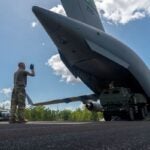By Ann Roosevelt The 2nd Infantry Division's 4th Battalion, 9th Infantry Regiment (Manchu's) soldiers in Iraq asked for and will receive the ability to pinpoint snipers in the next few weeks for their General Dynamics' [GD]-developed Land Warrior systems, a company official said. "The Manchu's are experiencing tremendous tactical advantages with Land Warrior and the combat power it brings to COIN operations is clear," Col. Richard Hansen, project manager, Soldier Warrior, tells Defense Daily. Developed by the Army's Program Executive…
Contract Updates
Oshkosh Defense LLC (Oshkosh, Wisconsin) – $29,432,585
Oshkosh Defense LLC, Oshkosh, Wisconsin, has been awarded an estimated $29,432,585 firm-fixed-price, indefinite-delivery/indefinite-quantity contract for steering gears. This was a sole-source acquisition using justification 10 U.S. Code 3204 (a)(1), as stated in Federal Acquisition Regulation 6.302-1. This is a three-year…
Propper International Inc. (Cabo Rojo, Puerto Rico) – $48,380,842
Propper International Inc., Cabo Rojo, Puerto Rico, has been awarded a maximum $48,380,842 fixed-price, indefinite-delivery/indefinite-quantity contract for flame resistant pants. This was a competitive acquisition with four responses received. This is a one-year contract with no option periods. The ordering…
Northrop Grumman Systems Corp. (Rolling Meadows, Illinois) – $50,000,000
Northrop Grumman Systems Corp., Rolling Meadows, Illinois, was awarded a $50,000,000 modification (P00033) to a previously awarded contract (FA8540-19-D-0001) for LITENING CATP program. This modification brings the total face value of the contract to $1,360,000,000 from $1,310,000,000. This action does…
World Wide Technology LLC (St. Louis, Missouri) – $15,285,426
World Wide Technology LLC, St. Louis, Missouri, is awarded a $15,285,426 firm-fixed-price contract. This effort procures Information Technology hardware and software in support of the Program Executive Office Digital Enterprise Services, Webster Outlying Field Integrated Command, Control and Intel Systems…













